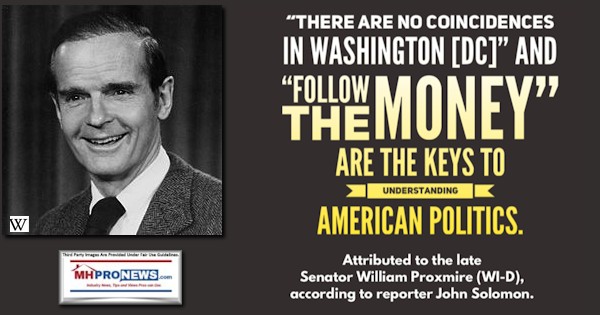There have been no mobile homes as such built in the U.S. in decades because the trailer house and mobile home industry were transformed by federal construction and safety standards established by Congress into HUD Code manufactured housing that officially began production on June 15, 1976. New manufactured home production and shipment data was released on 4.5.2021 by the Manufactured Housing Association for Regulatory Reform, which cites official sources used by the U.S. Department of Housing and Urban Development (HUD), which is a primary federal regulator of the manufactured housing industry. The results are technically flat or statistically down, depending on how they are viewed. By contrast, as CNN reported last week, sales of existing ‘site-built’ homes are on a tear. Recent conventional housing building and sales data also reflects a significant surge when compared to HUD Code manufactured home construction. The new February 2021 manufactured housing production and shipment data report below – per MHARR – will be followed by additional information that cites several third-party research items, along with MHProNews analysis, and commentary.
FOR IMMEDIATE RELEASE Contact: MHARR
(202) 783-4087
HUD CODE PRODUCTION DECLINES AGAIN IN FEBRUARY 2021
Washington, D.C., April 5, 2021 – The Manufactured Housing Association for Regulatory Reform (MHARR) reports that according to official statistics compiled on behalf of the U.S. Department of Housing and Urban Development (HUD), HUD Code manufactured housing industry year-over-year production declined again in February 2021. Just-released statistics indicate that HUD Code manufacturers produced 7,995 homes in February 2021, a 2.9% decline from the 8,240 new HUD Code homes produced during February 2020. Cumulative production for 2021 now totals 16,471 homes, a 2.9% decline from the 16,973 homes produced over the same period in 2020.
A further analysis of the official industry statistics shows that the top ten shipment states from the beginning of the industry production rebound in August 2011 through February 2021 — with cumulative, monthly, current year (2021) and prior year (2020) shipments per category as indicated — are:
The February 2021 production data results in no changes to the cumulative top-ten list.
The Manufactured Housing Association for Regulatory Reform is a Washington, D.C.-based national trade association representing the views and interests of independent producers of federally-regulated manufactured housing.
— 30 —
###

The bullets of the latest production statistics above are as follows.
- 2.9% decline from February 2020 (8240 manufactured homes) to February 2021 (7995 manufactured homes).
- Noting that there was one day less due to leap year 2020, the ‘daily’ average would look like this: 7,995/28=54 units per each day of February 2021 vs. 8,240/29=284.14 February 2020. So essentially flat. However, there is still an overall decline year-to-date too.
- 2.9% decline from cumulative 2020 (16,973) to cumulative 2021 (16471).
The long term trends shown below beg several questions.
- Cui Bono? Who Benefits from Manufactured Housing’s (MH) Status Quo?
- Who are Harmed by Status Quo?
- Why has the Manufactured Housing Institute (MHI) leadership tolerated this status quo for years on end, while conventional housing has risen during an affordable housing crisis?
- What do Third-Party Researchers and MH Insider Sources Say?

Additional Information, More MHProNews Analysis and Commentary
With few exceptions, MHProNews and MHLivingNews are essentially alone in manufactured housing connected trade media or bloggers who have seriously reported on the following third-party research reports. Perhaps that should be expected, as we are the largest and apparently most read trade media.
With that brief backdrop, what is obvious to those who look at decades of the trend lines is that the since the mobile home industry pre-1976 transformed into the higher construction, safety and energy standards made law with the enactment of HUD Code manufactured housing, this segment of the factory built housing industry has never attained the same peaks that it did in the mobile home era. Why?
See the graphic above, which uses Skyline Champion (SKY) base data, noting that the orange and yellow call out boxes and arrows in that graphic are part of the MHProNews analysis.
As that illustration notes, one answer advanced to address that question is from James Schmitz Jr., a Minneapolis Federal Reserve researcher.

Schmitz and his colleagues have written several reports, one of which says: “a national subsidy program was started [by HUD for builders] for households buying stick-built homes…Under these programs, households purchased 430,000 stick-built homes (per year) in the early 1970s.” Schmitz alleges this as an example of modern “sabotage monopoly” that has artificially created or exacerbated the affordable housing crisis in America.

Schmitz, along with his colleagues, has flatly accused builders and HUD of undermining the industry. That in turn, they reasoned, has fostered the affordable housing crisis and increased homelessness. See two of several such reports by Schmitz and his colleagues. Informed sources tell MHProNews that these researchers plan to continue to push their concerns on this issue that is directly connected to manufactured housing.
While the research approach is quite different than that taken by Schmitz and his colleagues, Samuel Strommen from Knudson Law in a research report made evidenced-based allegations

Scholastica “Gay” Cororaton, CRE for the National Association of Realtors, did research on manufactured homes and the potential of the Manufactured Housing Market. She and other third party researchers – including links-downloads of their research – are found from the report linked below.

Beyond yet including regulatory items, there are routinely three issues that come up that point to ‘explanations’ for why manufactured housing is underperforming. They are zoning/placement, ample competitive financing, and the image issue. The “Pimple on an Elephant’s Ass” report explores the financing aspect of this crippling three legged stool

What Schmitz and the other reports directly or obliquely point to are issues related to the so-called “Iron Triangle” that exists that impacts several industries, including manufactured housing.

The case can be made that MHI is actively working to thwart the interests of independents. The pseudo-debate – linked below – between Doug Ryan/Prosperity Now and now MHI CEO Lesli Gooch is but one example of how that thwarting has occurred.








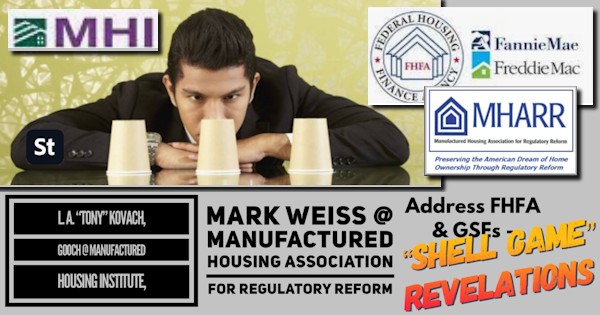
The above and what follows confirm the concerns raised in the “foot dragging” report below. The manufactured home industry already has the laws needed in place, what is missing is the proper implementation of those laws. MHI arguably postures efforts, but has failed for 12+ and 20+ years respectively to achieve an implementation of those laws. To apply the late Senator William Proxmire (WI-D) insight, this should not be seen as a coincidence.


MHARR, MHProNews, and other pro-ethical, sustainable growth advocates have made the argument that some new post-production unit is needed to supplant MHI, because they are apparently part of the problem, not part of the solution. When the trends are examined, the evidence-based answer to who benefits is consolidators at MHI.
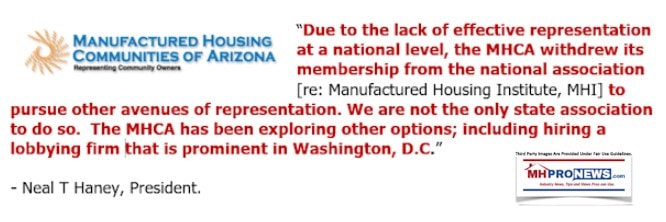

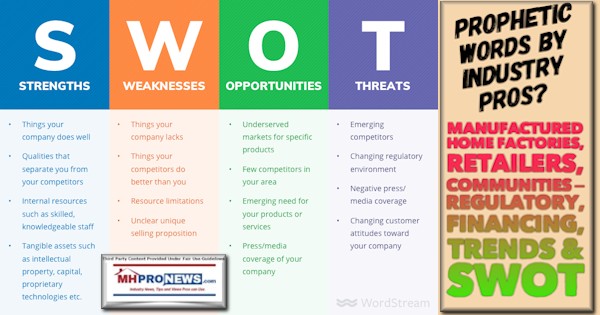
From time-to-time MHProNews gets a comments or feedback message – often from pro-MHI members – that essentially says that some of our reports have repetitive elements. There is truth to that, but with good reason. First, something similar occurs in mainstream and other trade media too. Next, the causes of manufactured housing underperformance have not changed. There has to be a good reason why the powers that be at MHI are not demanding robust performance from their staff. Instead, they have tolerated behavior and low outcome performance that benefits a few at a cost to the many. As new evidence comes in that thesis has to be tested again. What Schmitz and Strommen – as but two of the examples from above reflect – is that the MHProNews thesis that the system is rigged in manufactured housing to benefit a few at a cost to the many has stood the test of time. Indeed, that contention has only strengthened.

Put differently, until those core issues that lead to underperformance during an affordable housing crisis are resolved, it should be obvious that only more of the same will occur. To learn more, see the linked and related reports.
Complicating the issues are the reality that both financial and mainstream news tend to be reluctant in exposing the root problems in our industry, or others. Why? Because it takes a level of moxie to take on powerful interests such as Berkshire Hathaway. Here below is an example of a report that is only obliquely related to Berkshire, but where the financial reporting firm has not yet been willing to respond or correct their apparent misses and errors. Note that an informed source with ties to Legacy has confirmed the ‘fairness’ and accuracy of the analysis below. MHProNews has asked that source to go on the record, time will tell.

In conclusion, until the underlying issues are addressed, expect more of the same in the weeks and months ahead. The status quo works for the benefit of the ‘big boys’ in the industry, while it works to undermine the industry’s independents.




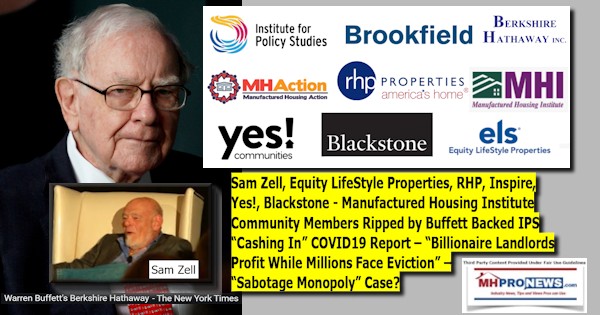

Stay tuned for more of what is ‘behind the curtains’ as well as what is obvious and in-your-face reports. It is all here, at the runaway largest and most-read source for authentic manufactured home “News through the lens of manufactured homes and factory-built housing” © where “We Provide, You Decide.” © ## (Affordable housing, manufactured homes, reports, fact-checks, analysis, and commentary. Third-party images or content are provided under fair use guidelines for media.) (See Related Reports, further below. Text/image boxes often are hot-linked to other reports that can be access by clicking on them.)

By L.A. “Tony” Kovach – for MHProNews.com.
Tony earned a journalism scholarship and earned numerous awards in history and in manufactured housing.
For example, he earned the prestigious Lottinville Award in history from the University of Oklahoma, where he studied history and business management. He’s a managing member and co-founder of LifeStyle Factory Homes, LLC, the parent company to MHProNews, and MHLivingNews.com.
This article reflects the LLC’s and/or the writer’s position, and may or may not reflect the views of sponsors or supporters.
Connect on LinkedIn: http://www.linkedin.com/in/latonykovach
Related References:
The text/image boxes below are linked to other reports, which can be accessed by clicking on them.









